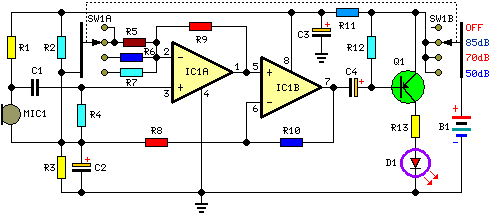
room noise detector circuit schematic

This circuit is designed to indicate, via a flashing LED, when room noise exceeds a predetermined threshold, selectable from three fixed levels: 50 dB, 70 dB, and 85 dB. The circuit utilizes two operational amplifiers to amplify the sound captured by a miniature electret microphone, which drives the LED. The switch SW1 has four positions; the first position turns the circuit off, while the second, third, and fourth positions activate the circuit and set the input sensitivity thresholds to 85 dB, 70 dB, and 50 dB, respectively. The circuit draws a current of 1 mA when the LED is off and 12-15 mA when the LED is continuously illuminated.
The circuit employs a miniature electret microphone as the primary sound sensing element. The microphone converts sound waves into electrical signals, which are then amplified by two operational amplifiers configured in a non-inverting gain configuration. This amplification is essential to ensure that the microphone's output is sufficient to drive the LED indicator effectively.
The operational amplifiers are powered by a dual supply voltage, which allows for a wide dynamic range and improved signal fidelity. The gain of the op-amps can be adjusted by changing the feedback resistors, allowing for fine-tuning of the sensitivity levels corresponding to the selected dB thresholds.
The threshold levels are set using a rotary switch (SW1), which connects different resistor values into the circuit to determine the sensitivity of the microphone. In the first position, the circuit is completely disabled, conserving power when not in use. In the second, third, and fourth positions, the circuit becomes active, with each position corresponding to one of the three noise threshold levels.
The LED serves as a visual indicator of the noise level. When the ambient noise exceeds the selected threshold, the op-amps output a signal that activates the LED. The LED will flash to indicate that the noise level is beyond the acceptable range, with the current consumption varying based on the state of the LED. In the off state, the circuit consumes approximately 1 mA, while in the active state with the LED illuminated, the current draw increases to between 12 mA and 15 mA, depending on the specific conditions and design of the circuit.
This circuit can be used in various applications, such as in sound-sensitive environments, noise monitoring systems, or as an educational project to demonstrate the principles of sound detection and signal processing. Properly designed, it can provide a reliable indication of noise levels, enhancing awareness of sound environments.This circuit is intended to signal, through a flashing LED, the exceeding of a fixed threshold in room noise, chosen from three fixed levels, namely 50, 70 & 85 dB. Two Op-amps provide the necessary circuit gain for sounds picked-up by a miniature electret microphone to drive a LED.
With SW1 in the first position the circuit is off. Second, third and fourth positions power the circuit and set the input sensitivity threshold to 85, 70 & 50 dB respectively. Current drawing is 1mA with LED off and 12-15mA when the LED is steady on.. 🔗 External reference
The circuit employs a miniature electret microphone as the primary sound sensing element. The microphone converts sound waves into electrical signals, which are then amplified by two operational amplifiers configured in a non-inverting gain configuration. This amplification is essential to ensure that the microphone's output is sufficient to drive the LED indicator effectively.
The operational amplifiers are powered by a dual supply voltage, which allows for a wide dynamic range and improved signal fidelity. The gain of the op-amps can be adjusted by changing the feedback resistors, allowing for fine-tuning of the sensitivity levels corresponding to the selected dB thresholds.
The threshold levels are set using a rotary switch (SW1), which connects different resistor values into the circuit to determine the sensitivity of the microphone. In the first position, the circuit is completely disabled, conserving power when not in use. In the second, third, and fourth positions, the circuit becomes active, with each position corresponding to one of the three noise threshold levels.
The LED serves as a visual indicator of the noise level. When the ambient noise exceeds the selected threshold, the op-amps output a signal that activates the LED. The LED will flash to indicate that the noise level is beyond the acceptable range, with the current consumption varying based on the state of the LED. In the off state, the circuit consumes approximately 1 mA, while in the active state with the LED illuminated, the current draw increases to between 12 mA and 15 mA, depending on the specific conditions and design of the circuit.
This circuit can be used in various applications, such as in sound-sensitive environments, noise monitoring systems, or as an educational project to demonstrate the principles of sound detection and signal processing. Properly designed, it can provide a reliable indication of noise levels, enhancing awareness of sound environments.This circuit is intended to signal, through a flashing LED, the exceeding of a fixed threshold in room noise, chosen from three fixed levels, namely 50, 70 & 85 dB. Two Op-amps provide the necessary circuit gain for sounds picked-up by a miniature electret microphone to drive a LED.
With SW1 in the first position the circuit is off. Second, third and fourth positions power the circuit and set the input sensitivity threshold to 85, 70 & 50 dB respectively. Current drawing is 1mA with LED off and 12-15mA when the LED is steady on.. 🔗 External reference
Warning: include(partials/cookie-banner.php): Failed to open stream: Permission denied in /var/www/html/nextgr/view-circuit.php on line 713
Warning: include(): Failed opening 'partials/cookie-banner.php' for inclusion (include_path='.:/usr/share/php') in /var/www/html/nextgr/view-circuit.php on line 713





